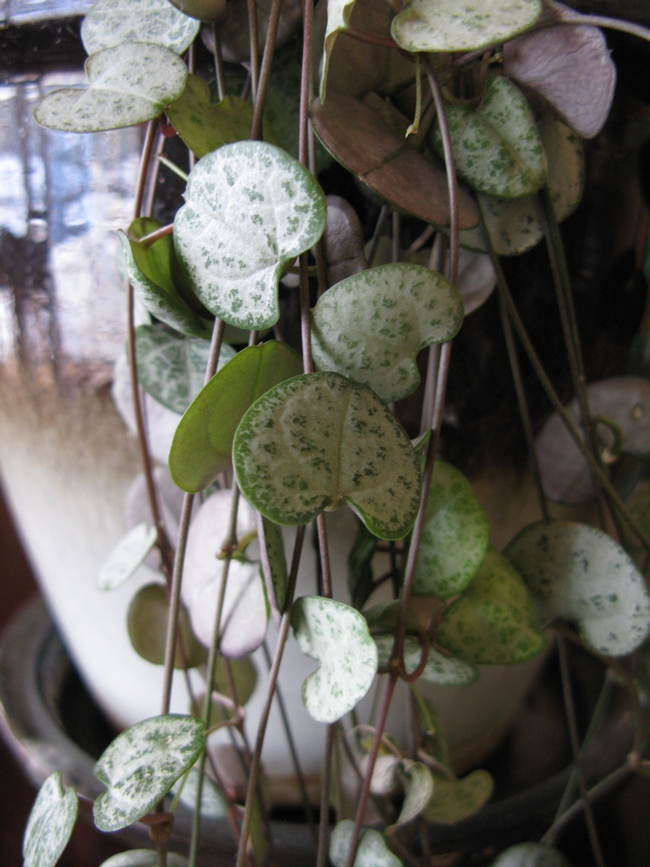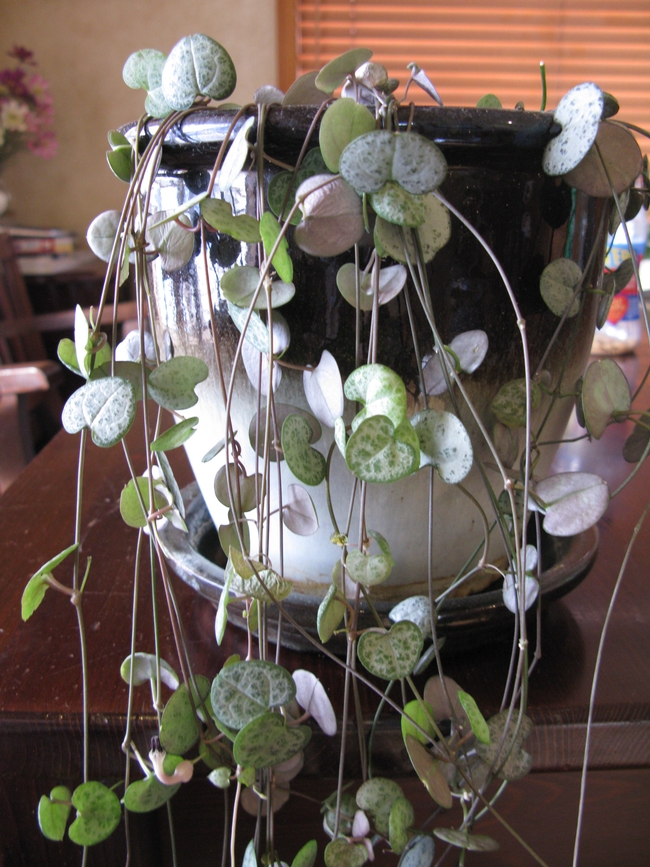What more appropriate house plant than a String of Hearts to help celebrate Valentine's Day? A generous friend of mine who is a lifelong gardener and also a master gardener in our Inyo-Mono Master Gardener group gave me her plant when I expressed interest in the lovely long trailing stems and heart shaped leaves. They are a succulent leaf about an inch wide, with a wonderful grey pattern providing quite a lot of visual interest. The backs of the leaves have a purple hue. Along the stems, the plant also produces funny little flowers which are about a half an inch long and vase-shaped with purple stamens protruding out of the end of the flower. These small flowers start out white, turning purplish as they age.
The botanical name of String of Hearts is Ceropegia woodii, also classified as Ceropegia linearis subspecies woodii. Like many of our fascinating house and landscape plants it originates in Africa where it is found from Zimbabwe to South Africa. The plant was officially collected in 1881 by John Medly Wood. J.M. Wood had many plants named after him, he was a self-trained botanist and, for a span of about 31 years, was the curator of Durban Botanic Gardens which is still an active botanic garden located just outside of Durban, South Africa. J.M. Wood collected the plant which was hanging from rocks, and as house plants they are wonderful in hanging baskets or looped up and over a frame or trained around a circular frame.

Ceropegia are classified in the Apocynaceae Family, Subfamily Asclepidia, the Milkweeds. All of the Ceropegia , scientific name from keros meaning wax and pege meaning fountain, have similar vase shaped flowers leading to common names like Dutchman's Pipe and Wineglass Flower. In their native habitat, the flowers are commonly pollinated by small flies. Tiny hairs on the inside of the flower trap the flies for a short time, the flies pollinating as they work to get out and emerging with pollen on their bodies. As they are fly pollinated, some of the flowers have an aroma only a fly would love, but on String of Hearts I have not detected any bad odor. Other common names for C. woodii are Sweetheart Vine, Hearts Entangled & Tangle Vine due to its ability to tangle each stem very readily. That is a characteristic I can vouch for. I wanted to see how long each stem was on my gift plant, and had quite a wrangle straightening one stem out to measure. Some websites list the stems as growing to 4 feet, but the stem I measured came to just short of 14 feet.
Ceropegia woodii needs a fast draining potting mix or the tubers and roots may rot. A commercial cactus mix works well, adding more perlite or sand to the mix to help with drainage. Water moderately and let the pot dry out between watering. Be careful not to overwater especially in the winter months. They only thrive outdoors in Subtropical and Tropical areas. In the Owens Valley where temperatures are high in the summer a potted String of Hearts may be taken outside to partial shade, but be careful of night time lows as they do not do well in temperatures lower than 60 degrees. In the house provide bright light for 3 to 4 hours per day in full to partial sun, doing well in normal room temperatures in the 60 degree range up to 75 degrees Fahrenheit. They seem to perform well in a crowded pot, so should not need repotting often. When it is time to repot, it is best done in spring, before they really start growing again. During the growing season, fertilize sparingly with a low nitrogen houseplant fertilizer at half strength of usual dosage, this could be done as much as once a month. Common pests are mealybugs, aphids and scale insects. Also watch for these at the soil line where they may go undetected.
Ceropegia woodii has the reputation of being easy to care for, very accepting of neglect and has a wonderful appeal with its cascade of heart shaped leaves. With common names like Hearts Entangled, Sweetheart Vine and String of Hearts who could resist treating your valentine to such a special plant?
Sources:
Royal Horticultural Society rhs.org.uk
SANBI South African National Biodiversity Institute www.sanbi.org
Plants Rescue www.plantsrescue.com/ceropegia-woodii/
